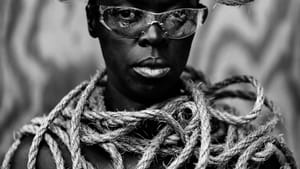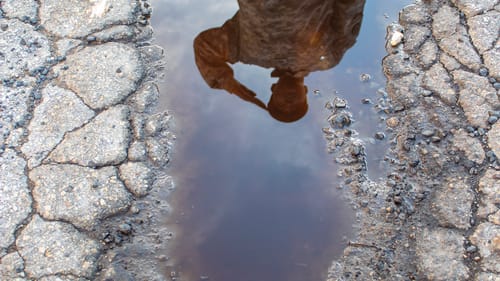Stay in the Loop
BSR publishes on a weekly schedule, with an email newsletter every Wednesday and Thursday morning. There’s no paywall, and subscribing is always free.
Portraits in other colors
PAFA and PPAC present the Women’s Mobile Museum

As it welcomes Zanele Muholi and the Women’s Mobile Museum (WMM), the Pennsylvania Academy of Fine Arts (PAFA) expands the vocabulary of portraiture to include bodies and perspectives previously excluded from an art form that historically aimed at further exalting the already exalted. Among the portraits lining PAFA’s permanent collection galleries are marble busts of distinguished statesmen, gilded-framed paintings of decorated military generals, and nude, alabaster-skinned goddesses from classical Greco-Roman mythology depicted in various states of luxurious repose.
Zanele Muholi is a searching and intensely perceptive photographer whose own work focuses on representations of queer black women in her native South Africa. She describes herself as a “visual activist,” and her images are a corrective to the racist, heteronormative tendencies of mainstream visual culture.
Muholi in Philadelphia
The WMM is a yearlong collaborative residency led by Muholi, in partnership with the Philadelphia Photo Arts Center (PPAC) and a diverse group of ten women artists based in Philadelphia. The project gave these women access to formal training, showcase opportunities, and resources that might otherwise have been unavailable to artists of their socioeconomic backgrounds.
Equipped with these tools, many of the artists have turned their lenses back on themselves. Muholi leads in this regard, continuing the exquisite series of self-portraits collected in her recently published monograph, Zanele Muholi: Somnyama Ngonyama, Hail the Dark Lioness.
The portraits feature Muholi, shot mainly from the shoulders up, in elaborate headdresses and costume pieces devised from feminine domestic objects and other detritus of Muholi's immediate surroundings. Muholi works these humble materials into ensembles that endow her with an imperious glamour that wouldn’t be out of place on the cover of Vogue Paris. But through her use of emphatically African iconography and her technique of heightening the color contrast of her compositions to make her dark skin appear even darker, Muholi tells a more complicated and critical story about reciprocal colonial desire.

After “don’t ask, don’t tell”
Among the Philadelphians she mentored, standouts include Davelle Barnes’s UNSAT series, which features self-portraits of the artist, a former US Army sergeant, in her camouflage fatigues. Having served under “don’t ask, don’t tell” as a queer, black woman, Barnes does not look much like the military officers whose portraits hang elsewhere in the museum, and she chooses to foreground different aspects of her service.
By partially exposing her breasts in Personal Statement, she confronts the viewer with the feminine contours her form-effacing regulation-issue uniform would otherwise conceal. In Oil and Concrete, she stands at attention, one arm raised in a salute, her image reflected in an oily slick of water pooled in a glistening, vaguely vulvular shape, masculine rigidity and feminine fluidity fused in a single, overdetermined image.
Strain and incandescence
Shana-Adina Roberts’s Black Incandescence series portrays a dark-skinned couple seeking — but never quite achieving — the repose attained by, say, the alabaster goddesses in the next gallery. Titles like Strain undercut any fragile serenity on display, and an omnipresent spotlight cutting through the shadows gives the subjects of these portraits a hunted quality, suggesting a pervasive anxiety and many sleepless nights.
Roland Barthes wrote that portrait photography creates a rehearsal for death; by fixing a model in time, the portrait allows the viewer to experience a record of a moment that will never be again. Though they exude a quiet resilience, Roberts’s portraits also seem very much engaged in the work of this kind of preemptive mourning.

Are you in or out?
Before making its way to PAFA (and, in January, to PPAC), WMM toured to community centers in Juniata Park and Point Breeze, neighborhoods where the city’s major art institutions may seem out of reach to many residents. This provided a platform for art to be made both by and for members of local communities often excluded from the mainstream arts scene.
That the work now hangs in PAFA, one of our finest museums, is in itself an achievement — but by opening the show in less established venues, Muholi seems to ask whether the real achievement might not be getting into the museum but rather getting out of it. This brings to mind the land artist Robert Smithson’s charge that museum galleries are spaces of “cultural confinement,” akin to asylums or jails, and that once inside, works of art undergo a kind of aesthetic convalescence, forced to submit to the unyielding neutrality of the architecture.
There is nothing neutral about the work Muholi and her collaborators have made, and it might have been interesting to see some of it placed more directly into conversation with objects from the permanent collection. This is something PAFA often does well when installing contemporary work — for example, the Rina Banerjee exhibition on display through March 31. As it stands, it is still a great pleasure to see so many new faces at PAFA, and an even greater one to know that they are being seen all around the city that inspires them.
What, When, Where
The Women’s Mobile Museum. Through March 31, 2019 at the Richard C. von Hess Foundation Works on Paper Gallery, in partnership with the Philadelphia Photo Arts Center, at the Pennsylvania Academy of Fine Arts, 118-128 North Broad Street, Philadelphia. (215) 972-7600 or pafa.org.
Sign up for our newsletter
All of the week's new articles, all in one place. Sign up for the free weekly BSR newsletters, and don't miss a conversation.

 Jessica Rizzo
Jessica Rizzo